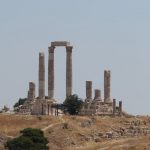Post facilitated by Melissa Harkin, PLD Blog Co-Editor
Last year, I quit my localization job in Silicon Valley to go on a sabbatical leave with my husband. We wanted to both travel the world and combine our travels with some meaningful volunteer experience.
The idea was born after hearing about the experience someone we knew had had as a volunteer in one of Jordan’s ever-growing refugee camps. He had taught us capoeira (a Brazilian synthesis of martial arts, dance, and music), so we contacted the same local nonprofit he worked with and offered to volunteer as capoeira instructors at a cultural center in Amman. After being accepted, we worked with Syrian refugee children whose families had already been allowed to relocate to the country’s crowded capital. Locally, these families are considered lucky to have had the chance to leave the refugee camps and resettle in the city.

According to the UNHCR, of each 1,000 people now living in Jordan, 89 are refugees. Globally, this makes Jordan the country with the second highest number of refugees compared to its population. This represents huge logistical challenges for this small Middle Eastern country, and the still-ongoing war in Syria means these are unlikely to diminish.
In total, we spent two months in Jordan. Of those two months, one was dedicated to working with a group of 24 Syrian refugee children and giving them introductory capoeira lessons. Those unfamiliar with capoeira might be surprised to hear that it has now spread globally to up to 150 countries and become a significant means of promoting Brazilian culture and language, something that the Brazilian Ministry of Culture quickly capitalized on over a decade ago.[i] In fact, some children already knew what capoeira was, since there were some active capoeira groups performing in the city.
Giving capoeira lessons to Arabic-speaking children was both rewarding and demanding. I will only concentrate on the language aspect of this experience and skip the war trauma the children have been subjected to (this alone posed different challenges to us).
I started learning Arabic three months before moving to Amman, and we took intensive classes in Arabic when we got there, but nothing prepares you to the real, daily challenges faced by language and cultural barriers in a totally different learning environment. The organization had already thought about the language barrier, so we had a teaching assistant to help us with Arabic. Besides the teaching assistant, the Jordanian and Syrian staff at the cultural center were fluent in English. These kind and altruistic people helped us overcome the linguistic issues we had with the children.
Thankfully, capoeira itself allows for a lot of nonverbal communication strategies, and the linguist and teacher in me was sort of equipped with some knowledge that forced me to think quickly and constantly change teaching methods on the spot. Being aware that even paralinguistic phenomena like intonation and stress are molded by an individual’s culture, I had to tread carefully on this new path and avoid simplistic assumptions that my nonverbal strategies (or, for that matter, some capoeira movements and codes) would smoothly apply in this new scenario. With time and a lot of interest in the children’s culture and background, we started to adapt to their learning needs. We increased our Arabic vocabulary daily, and it was really rewarding to see the children’s reactions to our attempts to use their native language to communicate with them.
Capoeira has a musical aspect that involves a lot of singing and learning of lyrics. One of the most fulfilling moments of this project was seeing the children singing in Portuguese after a few music classes. Singing and playing instruments is as much part of their culture as it is of mine, and it was very moving to achieve a new level of mutual understanding with the children through music and singing. Using similar sounds in both Arabic and Portuguese, some of the children even started making puns with the songs’ words, which would bring a lot of laughter to the group.
Overall, this experience shed light on the importance of extra-linguistic teaching strategies, especially on the areas of kinesics (nonverbal communication such as gestures and facial expressions) and proxemics (how humans make use of space and how this affects their behavior and communication). Another important aspect for me was to see the nuances of International English and how crucial it is for translators like me to be sensitive to and knowledgeable enough in matters dealing with culturally-neutral content to be used in a learning environment.
It’s been a month since we came back to the US, and the differences between people’s needs and worries in the world have never seemed so blatant. With a grateful attitude for all the experiences we had, we start a new journey again.
 Luciana Meinking has been working in translation and localization for over eight years. Originally from Brazil, Luciana completed her master’s degree and Ph.D. in English and Portuguese Philological Studies at the University of Freiburg (Germany). Some of her latest projects include translations of corporate communication, technical reports, and assessments for large multinational companies. As of May 2018, she is a new resident of Buffalo, NY.
Luciana Meinking has been working in translation and localization for over eight years. Originally from Brazil, Luciana completed her master’s degree and Ph.D. in English and Portuguese Philological Studies at the University of Freiburg (Germany). Some of her latest projects include translations of corporate communication, technical reports, and assessments for large multinational companies. As of May 2018, she is a new resident of Buffalo, NY.
[i] Here’s a great link about capoeira in Portuguese:
https://portal.iphan.gov.br/uploads/ckfinder/arquivos/Dossi%C3%AA_capoeira.pdf
Here’s another in English, French, and Portuguese:

Amazing! I had the opportunity to work with young refugees in the US using the arts to help them to improve their English and community-building; that said, I totally share with you the importance of extra-linguistic activities (which particularly should be incorporated in other settings as well).
Loved your post, thanks for sharing this experience.